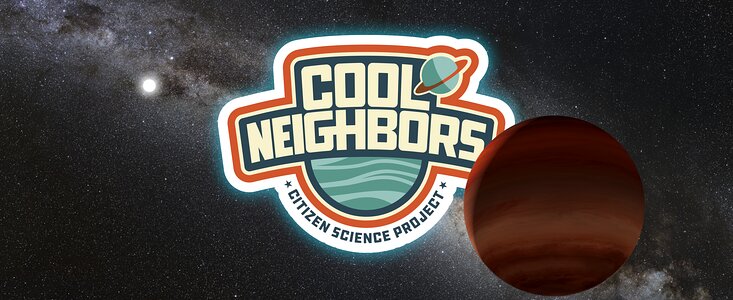Calling All Science-Sleuthing Volunteers! Astronomers Need Your Help Searching for Brown Dwarfs in Our Cosmic Backyard
NSF’s NOIRLab launches Cool Neighbors, an exciting new citizen-science opportunity
27 June 2023
From comets and pulsars to supernovae and exoplanets, many exciting cosmic discoveries have been made by dedicated amateur astronomers, school students, and citizen scientists. Some of these intrepid science sleuths also partner with professional astronomers, using their combined resources and analytic skills to answer particularly vexing questions.
One important area of research that has benefited greatly from citizen scientists is the search for brown dwarfs, vast spheres of gas that are not quite massive enough to become stars yet are too massive to be considered planets. Since brown dwarfs lack the internal nuclear reactions that power stars, they are extremely faint and difficult to detect, even with world-class observatories. Many could be hiding in our own galactic backyard, within just a few dozen light-years from the Sun.
To turbocharge the hunt for these cool cosmic neighbors, NSF’s NOIRLab has launched Backyard Worlds: Cool Neighbors, a citizen-science program that combines machine-learning tools and people-powered research to discover more of these elusive brown dwarfs. Cool Neighbors follows in the successful footsteps of and expands on Backyard Worlds: Planet 9, an ongoing companion citizen-science project hosted by Zooniverse.
Backyard Worlds: Planet 9 has used archival data from the Nicholas U. Mayall 4-meter Telescope at Kitt Peak National Observatory (KPNO) and the Víctor M. Blanco 4-meter Telescope at Cerro Tololo Inter-American Observatory (CTIO), which were made available through the Community Science and Data Center (CSDC), all programs of NSF’s NOIRLab, to uncover roughly 100 cool worlds near the Sun. Backyard Worlds: Planet 9 has also used the International Gemini Observatory (Gemini North and Gemini South) and the SOAR and Blanco telescopes to observe brown dwarfs discovered by members of the general public.
Cool Neighbors will feature data from NASA’s Wide-field Infrared Survey Explorer (WISE) telescope and may lead to follow-up observations with telescopes operated by NOIRLab and also with the NASA/ESA/CASA James Webb Space Telescope.
“Cool Neighbors expands on the popular Backyard Worlds: Planet 9 project with a dedicated search for brown dwarfs that now leverages machine learning,” said Aaron Meisner, an astronomer with NSF’s NOIRLab and Principal Investigator of the Cool Neighbors project. “Through this program and beyond, we are actively engaging undergraduate researchers in cutting-edge scientific projects at NOIRLab.”
The Cool Neighbors citizen-science project has been built by NOIRLab undergraduate research interns Austin Humphreys (University of Maryland, College Park), Grady Robbins (University of Florida), and Noah Schapera (Emory University).
To participate in Cool Neighbors, interested individuals need only visit the website, undergo some basic training, and then dive into the data to begin the search. Registration is optional.
More information
NSF’s NOIRLab (National Optical-Infrared Astronomy Research Laboratory), the US center for ground-based optical-infrared astronomy, operates the International Gemini Observatory (a facility of NSF, NRC–Canada, ANID–Chile, MCTIC–Brazil, MINCyT–Argentina, and KASI–Republic of Korea), Kitt Peak National Observatory (KPNO), Cerro Tololo Inter-American Observatory (CTIO), the Community Science and Data Center (CSDC), and Vera C. Rubin Observatory (operated in cooperation with the Department of Energy’s SLAC National Accelerator Laboratory). It is managed by the Association of Universities for Research in Astronomy (AURA) under a cooperative agreement with NSF and is headquartered in Tucson, Arizona. The astronomical community is honored to have the opportunity to conduct astronomical research on Iolkam Du’ag (Kitt Peak) in Arizona, on Maunakea in Hawai‘i, and on Cerro Tololo and Cerro Pachón in Chile. We recognize and acknowledge the very significant cultural role and reverence that these sites have to the Tohono O’odham Nation, to the Native Hawaiian community, and to the local communities in Chile, respectively.
Links
- http://coolneighbors.org/ - Zooniverse web interface for Cool Neighbors
- http://blog.coolneighbors.org/ - Backyard Worlds blog
Contacts
Aaron Meisner
NSF’s NOIRLab
Email: aaron.meisner@noirlab.edu
Charles Blue
Public Information Officer
NSF’s NOIRLab
T: +1 202 236 6324
Email: charles.blue@noirlab.edu





